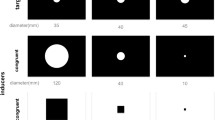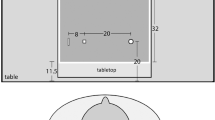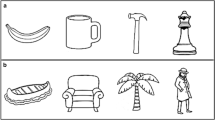Abstract
Grasping using two forelimbs in opposition to one another is evolutionary older than the hand with an opposable thumb (Whishaw and Coles in Behav Brain Res 77:135–148, 1996); yet, the mechanisms for bimanual grasps remain unclear. Similar to unimanual grasping, the localization of matching stable grasp points on an object is computationally expensive and so it makes sense for the signals to converge in a single cortical hemisphere. Indeed, bimanual grasps are faster and more accurate in the left visual field, and are disrupted if there is transcranial stimulation of the right hemisphere (Le and Niemeier in Exp Brain Res 224:263–273, 2013; Le et al. in Cereb Cortex. doi:10.1093/cercor/bht115, 2013). However, research so far has tested the right hemisphere dominance based on small objects only, which are usually grasped with one hand, whereas bimanual grasping is more commonly used for objects that are too big for a single hand. Because grasping large objects might involve different neural circuits than grasping small objects (Grol et al. in J Neurosci 27:11877–11887, 2007), here we tested whether a left visual field/right hemisphere dominance for bimanual grasping exists with large and thus more ecologically valid objects or whether the right hemisphere dominance is a function of object size. We asked participants to fixate to the left or right of an object and to grasp the object with the index and middle fingers of both hands. Consistent with previous observations, we found that for objects in the left visual field, the maximum grip apertures were scaled closer to the object width and were smaller and less variable, than for objects in the right visual field. Our results demonstrate that bimanual grasping is predominantly controlled by the right hemisphere, even in the context of grasping larger objects.


Similar content being viewed by others
References
Aramaki Y, Honda M, Okada T, Sadato N (2006) Neural correlates of the spontaneous phase transition during bimanual coordination. Cereb Cortex 16:1338–1348
Baas U, de Haan B, Grassli T, Karnath H-O, Mueri R, Perrig WJ, Wurtz P, Gutbrod K (2011) Personal neglect—a disorder of body representation? Neuropsychologia 49:898–905
Binkofski F, Buccino G (2006) The role of ventral premotor cortex in action execution and action understanding. J Physiol (Paris) 99:396–406
Binkofski F, Dohle C, Phil M, Posse S, Stephan KM, Hefter H, Seitz J, Freund HJ (1998) Human anterior intraparietal areas subserves prehension: a combined lesion and functional MRI activation study. Neurology 50:1253–1259
Blake A (1992) Computational modelling of hand-eye coordination. Philos Trans R Soc Lond [Biol] 337:351–360
Blake A, Taylor M, Cox A (1993) Grasping visual symmetry. In: Proceedings of the fourth international conference on computer vision. International conference on computer vision, Berlin
Blanke O, Ortigue S, Landis T, Seeck M (2002) Stimulating illusory own-body perceptions. Nature 419:269–270
Brainard DH (1997) The psychophysics toolbox. Spatial Vis 10:433–436
Byrne PA, Cappadocia DC, Crawford JD (2010) Interactions between gaze-centered and allocentric representations of reach target location in the presence of spatial updating. Vis Res 50:2661–2670
Castiello U (2005) The neuroscience of grasping. Nat Rev Neurosci 6:726–736
Castiello U, Begliomini C (2008) The cortical control of visually guided grasping. Neuroscientist 14:157–170
Cavina-Pratesi C, Monaco S, Fattori P, Galletti C, McAdam TD, Quinlan DJ, Goodale MA, Culham JC (2010) Functional magnetic resonance imaging reveals the neural substrates of arm transport and grip formation in reach-to-grasp actions in humans. J Neurosci 30:10306–10323
Cohen NR, Cross ES, Tunik E, Grafton S, Culham JC (2009) Ventral and dorsal stream contributions to the online control of immediate and delayed grasping: a TMS approach. Neuropsychologia 47:1553–1562
Cornelissen FW, Peters EM, Palmer J (2002) The Eyelink toolbox: eye tracking with MATLAB and the psychophysic toolbox. Behav Res Method Instrum Comput 34:613–617
Culham JC, Valyear KF (2006) Human parietal cortex in action. Curr Opin Neurobiol 16:205–212
Culham J, Danckert SL, DeSouza JFX, Gati JS, Menen RS, Goodale MA (2003) Visually guided grasping produces fMRI activation in dorsal but not ventral stream brain areas. Exp Brain Res 153:180–189
Davare M, Andres M, Clerget E, Thonnard J-L, Olivier E (2007) Temporal dissociation between hand shaping and grip force scaling in the anterior intraparietal area. J Neurosci 27:3974–3980
Davare M, Rothwell JC, Lemon RN (2010) Causal connectivity between the human anterior intraparietal area and premotor cortex during grasp. Curr Biol 20:176–181
Dohle C, Ostermann G, Hefter H, Freund H-J (2000) Different coupling for the reach and grasp components in bimanual prehension movements. NeuroReport 11:3787–3791
Duque J, Davare M, Delaunay L, Jacob B, Saur R, Hummel F, Hemoye L, Rossion B, Olivier E (2009) Monitoring coordination during bimanual movements: where is the mastermind? J Cogn Neurosci 22:526–542
Eastough D, Edwards MG (2007) Movement kinematics in prehension are affected by grasping objects of different mass. Exp Brain Res 176:193–198
Ehrsson HH, Fagergren A, Jonsson T, Westling G, Johansson RS, Forssberg H (2000) Cortical activity in precision-versus power-grip tasks: an fMRI study. J Neurophysiol 83:528–536
Faillenot I, Decety J, Jeannerod M (1999) Human brain activity related to the perception of spatial features of objects. Neuroimage 10:114–124
Frey SH, Vintonb D, Norlund R, Grafton ST (2005) Cortical topography of human anterior intraparietal cortex active during visually guided grasping. Cogn Brain Res 23:397–405
Galati G, Lobel E, Vallar G, Berthoz A, Pizzamiglio L, Le Bihan D (2000) The neural basis of egocentric and allocentric coding of space in humans: a functional resonance study. Exp Brain Res 133:156–164
Galletti C, Kutz DF, Gamberini M, Breveglieri R, Fattori P (2003) Role of the medial parieto-occipital cortex in the control of reaching and grasping movements. Exp Brain Res 153:158–170
Glover S, Miall RC, Rushworth MFS (2005) Parietal rTMS disrupts the initiation but not the execution of on-line adjustments to a perturbation of object size. J Cogn Neurosci 17:124–136
Gonzalez CL, Goodale MA (2009) Hand preference for precision grasping predicts language lateralization. Neuropsychologia 47:3182–3189
Gonzalez CLR, Ganel T, Goodale MA (2006) Hemispheric specialization for the visual control of action is independent of handedness. J Neurophysiol 95:3496–3501
Goodale MA, Meenan JP, Bülthoff HH, Nicolle DA, Murphy KJ, Racicot CI (1994) Separate neural pathways for the visual analysis of object shape in perception and prehension. Curr Biol 4:604–610
Grafton ST (2010) The cognitive neuroscience of prehension: recent developments. Exp Brain Res. doi:10.1007/s00221-010-2315-2
Grol MJ, Majdandžić J, Stephan KE, Verhagen L, Dijkerman HC, Bekkering H, Verstraten FAJ, Toni I (2007) Parieto-frontal connectivity during visually guided grasping. J Neurosci 27:11877–11887
Hughes CML, Franz EA (2008) Goal-related planning constraints in bimanual grasping and placing of objects. Exp Brain Res 188:541–550
Jackson GM, Jackson SR, Kritikos A (1999) Attention for action: coordinating bimanual reach-to-grasp movements. Br J Psychol 90:247–270
Jeannerod M (1981) Intersegmental coordination during reaching at natural visual objects. In: Long J, Baddeley A (eds) Attention and performance IX. Erlbaum, Hillsdale, NJ
Jeannerod M (1984) The timing of natural prehension movements. J Mot Behav 16:235–254
Knecht S, Dräger B, Deppe M, Bobe L, Lohmann H, Flöel A, Ringelstein E-B, Henningsen H (2000) Handedness and hemispheric language dominance in healthy humans. Brain 123:2512–2518
Koch G, Cercignani M, Pecchioli C, Versace V, Oliveri M, Caltagirone C, Rothwell J, Bozzali M (2010) In vivo definition of parieto-motor connections involved in planning of grasping movements. NeuroImage 51:300–312
Lang CE, Schieber MH (2003) Differential impairment of individuated finger movements in humans after damage to the motor cortex or the corticospinal tract. J Neurophys 90:1160–1170
Le A, Niemeier M (2013) A right hemisphere dominance for bimanual grasps. Exp Brain Res 224:263–273
Le A, Vesia M, Yan X, Niemeier M, Crawford JD (2013) The right anterior intraparietal sulcus is critical for bimanual grasping: a TMS study. Cereb Cortex. doi:10.1093/cercor/bht115
Lederman SJ, Wing AM (2003) Perceptual judgement, grasp point selection and object symmetry. Exp Brain Res 152:156–165
Lewis GN, Perreault EJ (2009) An assessment of robot-assisted bimanual movements on upper limb motor coordination following stroke. IEEE Trans Neural Syst Rehabil Eng 17:595–604
Li S, Latash ML, Yue GH, Siemionow V, Sahgal V (2003) The effects of stroke and age on finger interaction in multi-finger force production tasks. Clin Neurophysiol 114:1646–1655
Macaluso E, Frith CD, Driver J (2002) Crossmodal spatial influences of touch on extrastriate visual areas take current gaze direction into account. Neuron 34:647–658
Marotta JJ, McKeeff TJ, Behrmann M (2003) Hemispatial neglect: its effects on visual perception and visually guided grasping. Neuropsychologia 41:1262–1271
Medendorp WP, Crawford JD, Henriques DYP, van Gisbergen JAM, Gielen CCAM (2000) Kinematic strategies for upper arm-forearm coordination in three dimensions. J Physiol 84:2302–2316
Monaco S, Chen Y, Medendorp WP, Crawford JD, Fiehler K, Henriques DYP (2013) Functional magnetic resonance imaging adaptation reveals the cortical networks for processing grasp-relevant object properties. Cereb Cortex. doi:10.1093/cercor/bht006
Murata A, Gallese V, Lupino G, Kaseda M, Sakata H (2000) Selectivity for the shape, size, and orientation of objects for grasping in neurons of monkey parietal area AIP. J Neurophysiol 83:2580–2601
Napier JR (1956) The prehensile movements of the human hand. J Bone Joint Surg 38:902–913
Ochiai T, Mushiake H, Tanji J (2005) Involvement of the ventral premotor cortex in controlling image motion of the hand during performance of a target-capturing task. Cereb Cortex 15:929–937
Oldfield RC (1971) The assessment and analysis of handedness: the Edinburgh inventory. Neuropsychologia 9:97–113
Park JH, Shea CH (2002) Effector independence. J Mot Behav 34:253–270
Pelli DG (1997) The VideoToolbox software for visual psychophysics. Transforming numbers into movies. Spatial Vis 10:437–442
Pujol J, Deus J, Losilla JM, Capdevila A (1999) Cerebral lateralization of language in normal lefthanded people studied by functional MRI. Neurology 52:1038–1043
Rice NJ, Tunik E, Grafton ST (2006) The anterior intraparietal sulcus mediates grasp execution independent of requirement to update: new insights from transcranial magnetic stimulation. J Neurosci 26:8176–8182
Rice NJ, Tunik E, Cross ES, Grafton ST (2007) On-line grasp control is mediated by the contralateral hemisphere. Brain Res 1175:76–84
Rizzolatti G, Craighero L (2004) The mirror-neuron system. Annu Rev Neurosci 27:169–192
Rizzolatti G, Luppino G (2001) The cortical motor system. Neuron 31:889–901
Rizzolatti G, Fadiga L, Gallese V, Fogassi L (1996) Premotor cortex and the recognition of motor actions. Cogn Brain Res 3:131–141
Rochat P (1989) Object manipulation and exploration in 2- to 5-month-old infants. Dev Psychol 25:871–884
Rose DK, Winstein CJ (2004) Bimanual training after stroke: are two hands better than one? Top Stroke Rehabil 11:20–30
Sadato N, Yonekura Y, Waki A, Yamada H, Ishii Y (1997) Role of the supplementary motor area and the right premotor cortex in the coordination of bimanual finger movements. J Neurosci 17:9667–9674
Sakata H, Taira M (1994) Parietal control of hand action. Curr Opin Neurobiol 4:847–856
Sakata H, Taira M, Murata A, Gallese V, Tanaka Y, Shikata E, Kusunoki M (1996) Parietal visual neurons coding three-dimensional characteristics of objects and their relation to hand action. In: Their P, Karnath HO (eds) Parietal lobe contributions to orientation in 3D space. Springer, New York
Schlicht EJ, Schrater PR (2007) Effects of visual uncertainty on grasping movements. Exp Brain Res 182:47–57
Serrien DJ, Ivry RB, Swinnen SP (2006) Dynamics of hemispheric specialization and integration in the context of motor control. Nat Rev Neurosci 7:160–167
Shikata E, Hamzei F, Glauce V, Koch M, Weiller C, Binkofski F, Buchel C (2003) Functional properties and interactions of the anterior and posterior intraparietal areas in humans. Eur J Neurosci 17:1105–1110
Shmuelof L, Zohary E (2006) A mirror representation of others’ actions in the human anterior parietal cortex. J Neurosci 26:9736–9742
Siddiqui A (1995) Object size as a determinant of grasping in infancy. J Genet Psychol 156:345–358
Sleimen-Malkoun R, Temprado J–J, Berton E (2010) A dynamic systems approach to bimanual coordination in stroke: implications for rehabilitation and research. Medicina 46:374
Sleimen-Malkoun R, Temprado J-J, Thefenne L, Berton E (2011) Bimanual training in stroke: How do coupling and symmetry-breaking matter? BMG Neurology 11:1–9
Slota GP, Suh MS, Latash ML, Zatsiorsky VM (2012) Stability control of grasping objects with different locations of center of mass and rotational inertia. J Mot Behav 44:169–178
Smeets JBJ, Brenner E (1999) A new view on grasping. Mot Control 3:237–271
Smeets JBJ, Brenner E (2001) Independent movements of the digits in grasping. Exp Brain Res 139:92–100
Tanné J, Boussaoud D, Boyer-Zeller N, Rouiller EM (1995) Direct visual pathways for reaching movements in the macaque monkey. NeuroReport 7:267–272
Theys T, Pani P, van Loon J, Goffin J, Janssen P (2012) Three-dimensional shape coding in grasping circuits: a comparison between the anterior intraparietal area and ventral premotor area F5a. J Cogn Neurosci. doi:10.1162/jocn_a_00332
Thiebaut de Schotten M, Dell’Acqua F, Forkel SJ, Simmons A, Vergani F, Murphy DG, Catani M (2011) A lateralized brain network for visuospatial attention. Nat Neurosci 14:1245–1246
Tresilian JR, Stelmach GE (1997) Common organization for unimanual and bimanual reach-to-grasp tasks. Exp Brain Res 115:283–299
Tunik E, Frey SH, Grafton ST (2005) Virtual lesions of the anterior intraparietal area disrupt goal-dependent on-line adjustments of grasp. Nat Neurosci 8:505–511
Tunik E, Ortigue S, Adamovich SV, Grafton ST (2008) Differential recruitment of anterior intraparietal sulcus and superior parietal lobule during visually guided grasping revealed by electrical neuroimaging. J Neurosci 28:13615–13620
Vahrenkamp N, Przybylski M, Asfour T, Dillman R (2011) Bimanual grasp planning. In: Conference proceedings of the 11th IEEE-RAS international conference on Humanoid Robots, pp 493–499
van den Berg FE, Swinnen SP, Wenderoth N (2010) Hemispheric asymmetries of the premotor cortex are task specific as revealed by disruptive TMS during bimanual versus unimanual movements. Cereb Cortex 20:2842–2851
Vangheluwe S, Suy E, Wenderoth N, Swinnen SP (2006) Learning and transfer of bimanual multifrequency patterns: effector-independent and effector-specific levels of movement representation. Exp Brain Res 170:543–554
Vesia M, Bolton DA, Mochizuki G, Staines WR (2013) Human parietal and primary motor cortical interactions are selectively modulated during the transport and grip formation of goal-directed hand actions. Neuropsychologia 51:410–417
Weir PL, MacKenzie CL, Marteniuk RG, Carboe SL (1991) Is object texture a constraint on human prehension?: Kinematic evidence. J Mot Behav 23:205–210
Weiss PH, Rahbari NN, Lux S, Pietrzyk U, Noth J, Fink GR (2006) Processing the spatial configuration of complex actions involves right posterior parietal cortex: an fMRI study with clinical implications. Hum Brain Mapp 27:1004–1014
Wenderoth N, Debaere F, Sunaert S, van Hecke P, Swinnen S (2004) Parieto-premotor areas mediate directional interference during bimanual movements. Cereb Cortex 14:1153–1163
Whishaw IQ, Coles BLK (1996) Varieties of paw and digit movement during spontaneous food handling in rat: postures, bimanual coordination, preferences, and the effects of forelimb cortex lesions. Behav Brain Res 77:135–148
Author information
Authors and Affiliations
Corresponding author
Rights and permissions
About this article
Cite this article
Le, A., Niemeier, M. Left visual field preference for a bimanual grasping task with ecologically valid object sizes. Exp Brain Res 230, 187–196 (2013). https://doi.org/10.1007/s00221-013-3643-9
Received:
Accepted:
Published:
Issue Date:
DOI: https://doi.org/10.1007/s00221-013-3643-9




